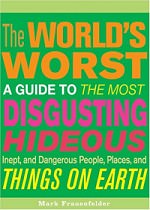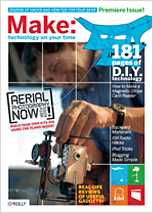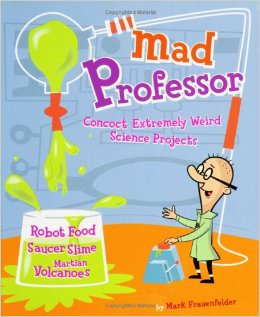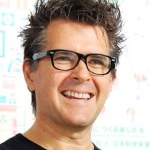Daniel Clowes interview
Frauenfelder interviews Clowes onstage at the 2014 Launch Event at Meltdown Comics in Hollywood, about the release of The Art Of The Modern Cartoonist: Daniel Clowes, creating the Eightball comics and the spinoff Ghost World series. Clowes tells Frauenfelder how he became interested in comics when he was young:
We didn’t have a TV set, didn’t have video games…we just had books, and my brother left me this huge stack of comic books [when] he decided he’d go out and meet girls…My mom would say, Go play in your room, go read your comic books. They were [comics] from 1955-65, Marvel comics, DC comics…I remember reading those before I could read
Reason.com interview
Frauenfelder sits down with Reason.com managing editor Cavanaugh to talk about do-it-yourself superhumanism, ‘unschooling’, and the future of print journalism. Frauenfelder:
You know, I studied mechanical engineering in school and I ended up becoming a journalist. I can name a dozen people right now that I think are amazing people who didn’t go to college.
Maker Faire selections
0 CommentsFrauenfelder picks the projects he likes the best from the event’s Maker challenge, including a motorized skateboard with treads that allow it to go offroad, a giant Tesla coil that plays melodies on-stage, chariot pulled by a skateboarding robot, a 69-foot fire-breathing dragon built from steel and found objects, and a lifesize robot giraffe.
Made By Hand
0 Comments Frauenfelder publishes the do-it-yourself guide, subtitled Searching for Meaning in a Throwaway World and including projects to whittle spoons, modify an espresso machine, make musical instruments, and raise chickens.
Frauenfelder publishes the do-it-yourself guide, subtitled Searching for Meaning in a Throwaway World and including projects to whittle spoons, modify an espresso machine, make musical instruments, and raise chickens.
I’m not afraid to tackle things that I haven’t done before. I have already come to terms with the fact that I’m going to make a lot of mistakes. And that’s O.K. I feel I can handle things that happen in my life now, and I don’t have to depend on outsourcing everything to experts to come and save me all the time.
Sauerkraut recipe
0 CommentsFrauenfelder shows how to make his version of sauerkraut for CHOW’s My Go-To show, and demonstrates a canjo – banjo made from a soup can with an electric buzzer for a pickup.
I found out how easy [sauerkraut] was to make, and also the probiotic value
TEDxKids@Brussels – Brushbot workshop
0 CommentsFrauenfelder demonstrates how to make a Brushbot, a ‘vibrobot’ made from a toothbrush and powered by a cellphone vibrator motor. The finished product creates a colorful robot that spins around on the floor.
TEDxKids@Brussels talk
0 CommentsFrauenfelder talks onstage about how Make:‘s readership includes many families, rather than being only a male audience, and how readership of around 160,000 ‘broad-spectrum enthusiasts’ compares with pop-science and DIY magazines in the 1950s that had circulations of five million, how the maker movement has the potential to become much bigger and how Maker Faire is a ‘science fair on steroids’. For makers:
The variety of tools and services that are available to them are just exploding now
Authors@Google interview
Frauenfelder talks about Made By Hand and how he became interested in urban homesteading, how making wooden eating utensils provides a bigger return on investment than projects like making a cool robot, and the different kinds of projects that can be done such as raising bees and chickens.
I set out with a couple of goals — to improve my family’s home life by taking an active role in the things that feed, clothe, educate, maintain, and entertain us, and to gain a deeper connection and sense of engagement with the things and systems that keep us alive and happy.
TIME interview
Frauenfelder talks about the do-it-yourself movement, and how people need to take time out from busy everyday routines to concentrate on simple things:
It’s really hard to do, you have to steal it [time] here and there from your life. I try to set aside a little bit of time each day to do something that allows me to slow down and just concentrate fully on a task. And it’s really a good thing to do, because when I’m sitting in front of my computer I’m multitasking — I have 17 windows open and website tabs and e-mails and blog posts, and it’s all going on at once, just a swirl. And if I take a break and go outside and put on my bee suit and check out my bees, it’s such a great experience. I’m not thinking about anything else except those bees. I’m really present in the moment.
Intelligentsia Coffee and Tea tour
Frauenfelder visits Intelligentsia for a tour with Glanville, the 2008 U.S. Barista Champion who is also espresso research and development director at the company. Glanville explains why the company focuses on importing beans from East Africa and Latin America:
As a relatively small company we feel like we need to focus on places where potential is high, and it won’t take a lot to realize it.
Demonstrates modified espresso machine
Frauenfelder shows Glanville, the U.S. Barista Champion, the espresso machine he modified. Glanville:
If your coffee smells like burnt wheat at all, then you know it’s overextracted
SigGraph Maker Night
0 CommentsMahalo’s Lon Harris meets Univac, a maker who has hacked a Teletubbie to display graphics on a screen when he touches it, Brett Doar, who made the Bronco table, a piece of ‘feral furniture’ that bucks when people try to place things on it in order to make life difficult, and interviews Frauenfelder about becoming involved in the maker community. He talks about how makers have learned to make hard-to-source parts for old cars by casting them from aluminum from melted beer cans, and how the internet has sped up the evolution of the community. Frauenfelder:
Do-it-yourself communities, special interest communities, people who are into doing something…These communities of interest really propel each other and evolve, and are making things so much faster since the internet
LA Times feature
Sinclair and Frauenfelder are profiled for the newspaper, focusing on how Craft and Make magazines were launched after their time in Rarotonga, where they created dolls, clothes, and household requirements from coconuts, twigs, shells, and items borrowed from their neighbours. They had no cellphone, no television and a dial-up Internet connection that cost $6 an hour, and people helped Frauenfelder diagnose a sore on his leg over the internet, as there was no dermatologist on the island.
The Computer
0 Comments Frauenfelder publishes the guide to the history of computers, from codebreaking in World War 2, the battle between Apple and IBM in the 1980s, to use of computers in film and TV such as in 1950’s The Forbidden Planet, up to the current-day era of wearables.
Frauenfelder publishes the guide to the history of computers, from codebreaking in World War 2, the battle between Apple and IBM in the 1980s, to use of computers in film and TV such as in 1950’s The Forbidden Planet, up to the current-day era of wearables.
The World’s Worst
0 Comments Frauenfelder publishes the book, which is intended as a catalogue of the worst people, places, and things. It includes entries on Miracle Mike The Headless Chicken, the world’s least adorable pet who survived for 18 months after being decapitated and was fed corn mash down his severed neck to keep him alive, the worst diet, Breatharianism, in which an Australian woman claims to have lived only on air and light since 1993, and the craziest scientist, Dr. Sidney Gottlieb of the CIA, who ran the MK-Ultra mind-control-experiment project and drugged people including the artist Stanley Gottlieb with acid, to see how they would react.
Frauenfelder publishes the book, which is intended as a catalogue of the worst people, places, and things. It includes entries on Miracle Mike The Headless Chicken, the world’s least adorable pet who survived for 18 months after being decapitated and was fed corn mash down his severed neck to keep him alive, the worst diet, Breatharianism, in which an Australian woman claims to have lived only on air and light since 1993, and the craziest scientist, Dr. Sidney Gottlieb of the CIA, who ran the MK-Ultra mind-control-experiment project and drugged people including the artist Stanley Gottlieb with acid, to see how they would react.
Make magazine
0 Comments Frauenfelder launches the magazine after returning from Rarotonga, where he and his family developed maker skills by creating clothes, dolls, and food out of coconuts, twigs, shells, and items their neighbours lent them. He talks about the most common type of reader:
Frauenfelder launches the magazine after returning from Rarotonga, where he and his family developed maker skills by creating clothes, dolls, and food out of coconuts, twigs, shells, and items their neighbours lent them. He talks about the most common type of reader:
They are curious about how the world around them works, and they want to have a say beyond just the purchasing decision in the technology they use. They like to alter technology to make it highly personal. And once they figured out how to do something neat, they can’t wait to share the idea with other people.
Move to Rarotonga
Sinclair and Frauenfelder move with their children to the small South Pacific island in the Cook Islands chain, planning to stay there for a year:
Memories of L.A.’s bumper-to-bumper traffic, acrylic nails, DSL, and prepackaged diversions for kids are beginning to lose their edge…It only took about five minutes to wipe out any preconceived fantasies we had about island life. The shuttle that picked us up drove past a long stretch of petrol tanks, refineries and warehouses. We didn’t remember any of this from our first visit. Of course, they’ve always been here, but our idealized notion of Rarotonga had replaced our actual memories. Now that we’d come back, in a van that reeked of diesel exhaust, passing little houses on the side of the road with missing windows, rotting roofs, and torn curtains in lieu of doors, the previous six months of romanticizing flew from our heads, to be replaced by dread: What the f-ck had we gotten ourselves into?
The Mad Professor
0 Comments Frauenfelder publishes the collection of science experiments for kids, which has wipeable pages and includes recipes for a countertop volcano, making slimes and putties, growing crystal gardens, creating Robot Food, Goon Goo, and Top-Secret Ink.
Frauenfelder publishes the collection of science experiments for kids, which has wipeable pages and includes recipes for a countertop volcano, making slimes and putties, growing crystal gardens, creating Robot Food, Goon Goo, and Top-Secret Ink.
Happy Mutant Handbook
 Sinclair and Frauenfelder publish the book, co-edited with Gareth Branwyn, featuring a scale that allows readers to rate themselves as a Happy Mutant, normal person, or Unhappy Mutant, and entries on ‘Invasion of the Paper Smiles,’ Joey Skaggs, ‘Cacophony Society,’ Toys and Cool Tools, and ‘Are Fan Club Presidents Nuts?’
Sinclair and Frauenfelder publish the book, co-edited with Gareth Branwyn, featuring a scale that allows readers to rate themselves as a Happy Mutant, normal person, or Unhappy Mutant, and entries on ‘Invasion of the Paper Smiles,’ Joey Skaggs, ‘Cacophony Society,’ Toys and Cool Tools, and ‘Are Fan Club Presidents Nuts?’
Wired.com launched
0 CommentsFrauenfelder launches the website as its editor-in-chief. His responsibilities:
[..] managing a team of editors, designers, and producers to develop Wired’s online presence
